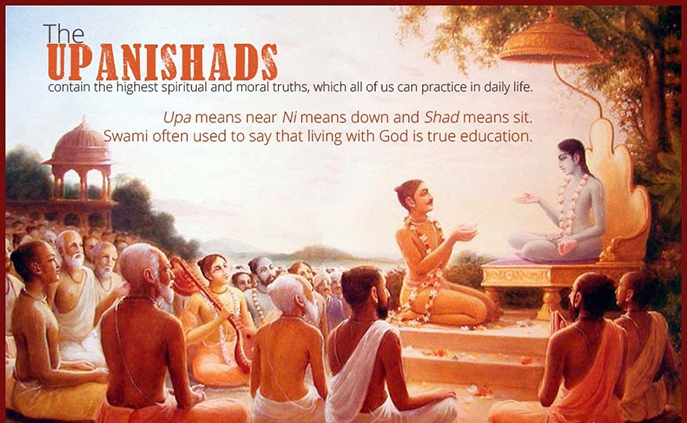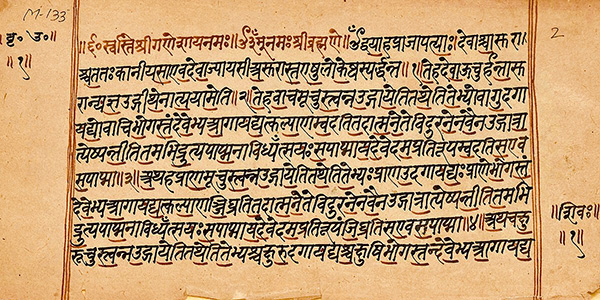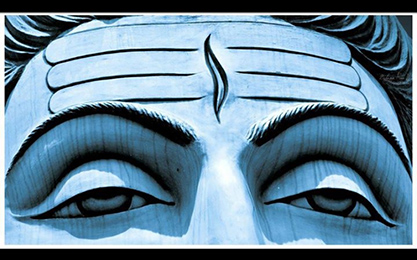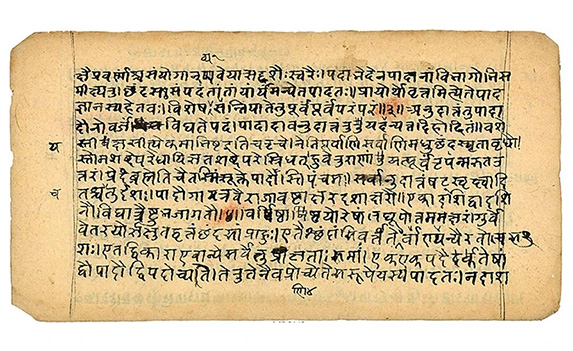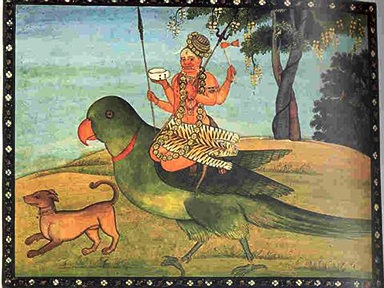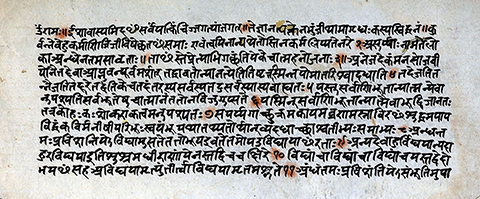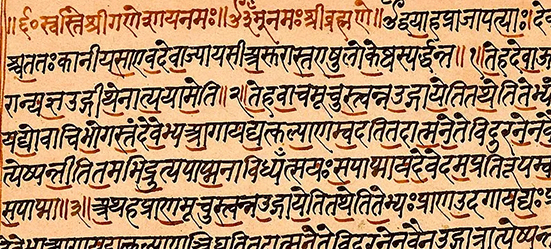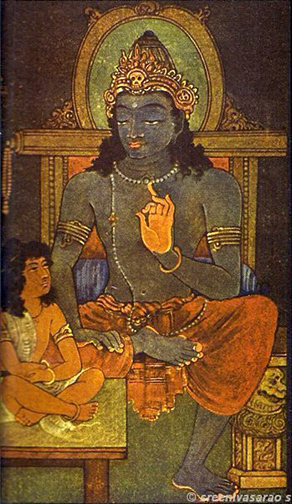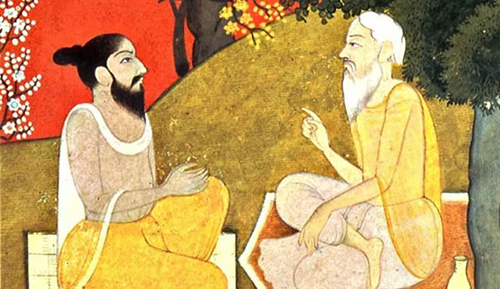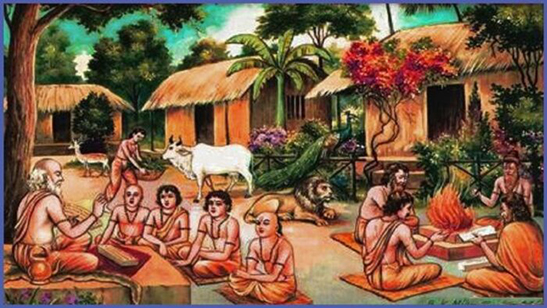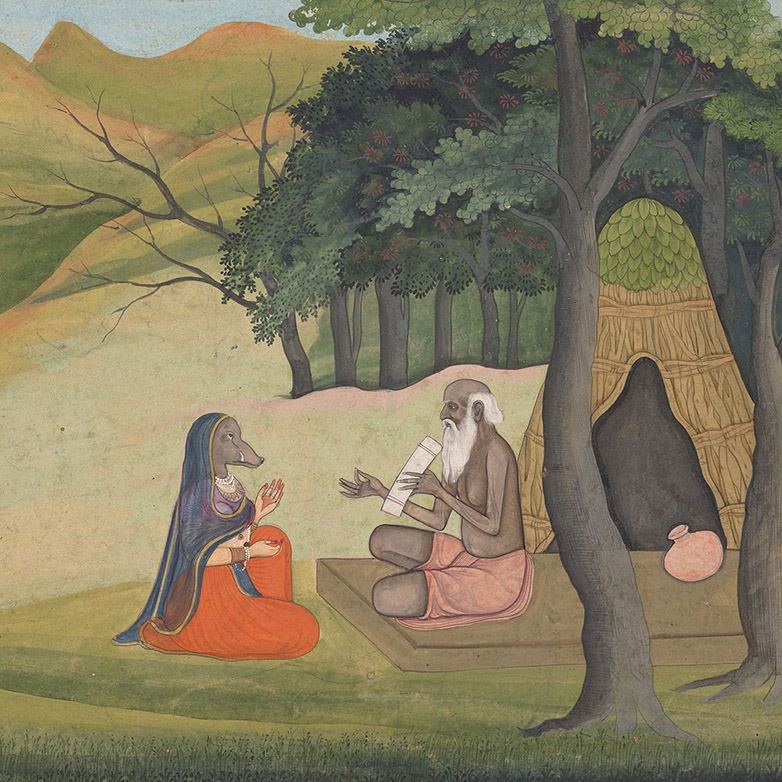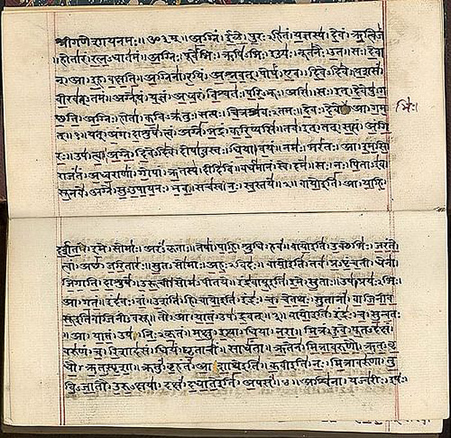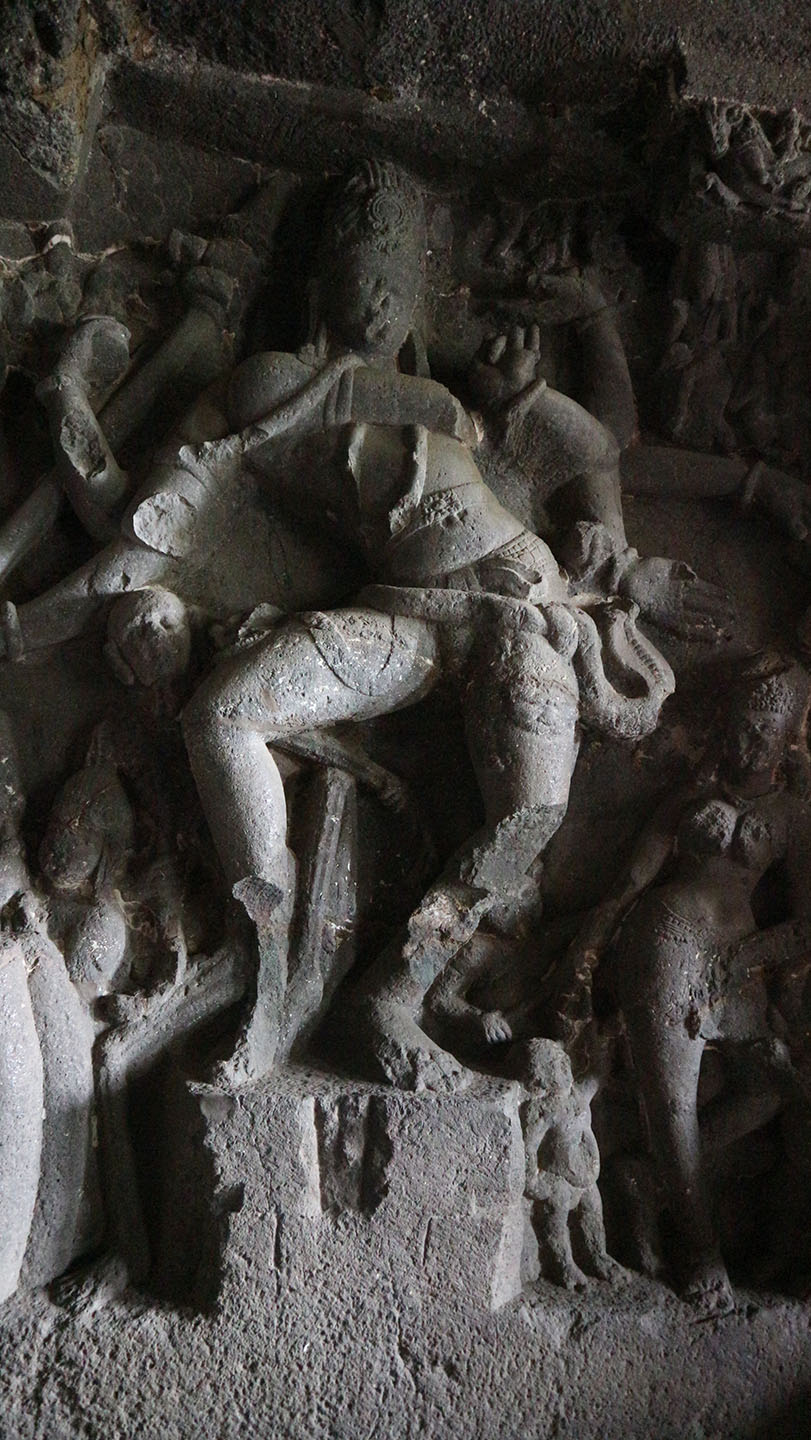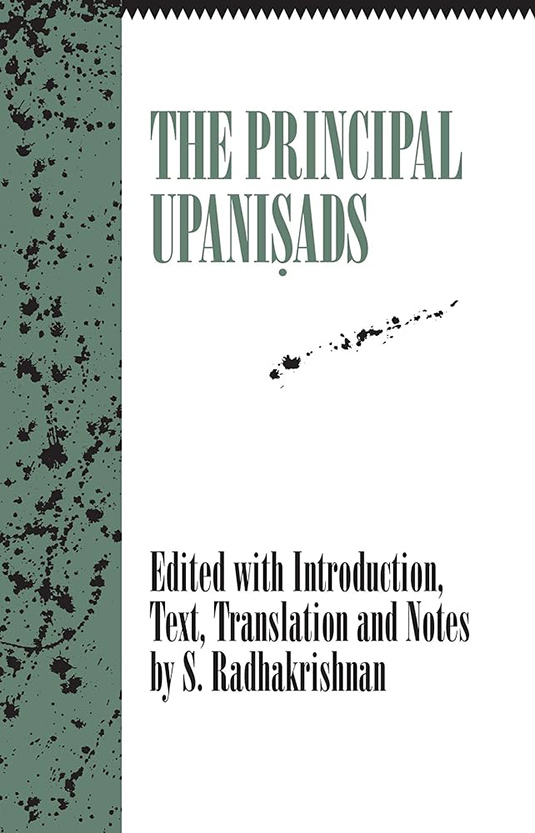Title Thumbnail & Hero Image: The Upaniṣads, source: thehinduportal.com, access date: Nov.21, 2023.
The Upaniṣads: Summary01, 02.
First revision: Nov.20, 2023
Last change: Jun.20, 2024
Searched, Gathered, Rearranged, and Compiled by Apirak Kanchanakongkha.
Page 1
The Upaniṣads (The part that explains the philosophical feelings. It does not involve prayers or rituals. Part of the scriptures arose to satisfy human needs. In addition to the ceremony, it aims to find an explanation that will allow people to reach liberation from the cycle of rebirth and death. Thus, The Upaniṣads represent the intellectual class seeking life's meaning or ideology.)
Upaniṣads comes from the root word Upa+ni+ṣads, meaning upa means "near or by", ni means close. carefully, diligently, for the word ṣads has three meanings: one) to sit down, two) to destroy, and three) to relieve and release, or ni-ṣads means "sit down, sit down near." In sum, the meaning of Upaniṣads means to sit near the disciple with an attitude of concentration. To receive the transmission of the highest truth will destroy or eliminate all doubts from the mind. {Incidentally, M. Hiriyanna has given a summary introduction to the Upaniṣads as follows: "The word Upaniṣads means mysterious teaching (mystic code) or teaching reserved for those not fit to know it and teach privately to students who have the character of diligence. Although there are many, this teaching has been gradually refined into the Upaniṣads. But only about twelve scriptures are considered to be the true Vedas. The rest are scriptures collected in the latter layer. And has inferior value to the original Traditional Upaniṣads. It represents the flowering of ideas in the Vedic period. Said is prose. It has a lead but no rhythm. Both have musical characteristics in themselves. Even readers unfamiliar with the teachings will be able to understand them easily. The influence of the teachings from this scripture is very prominent."} It is one of the four parts of the Brahmanical scriptures called the Vedas or the Triveda (Three Vedas of the Hindu religion).
The Vedas are divided into four parts:
one) Mandra,
two) Brahman,
three) Aranyaka, and
four) Upaniṣads.
Among the Upaniṣads, refer to 01. In total, there are 18 Upaniṣads (some sources say that there are 108 Upaniṣads)01. as follows:
1). Bṛhad -āyaka Upaniṣad (कबृहदा उपनिषद्), "The Forest of Wisdom - The Forest of Wisdom" (Shukla Yajur Veda).
2). Chāndogya Upaniṣad (छान्दोग्योपनिषद्) "Song and Sacrifice - Sacred Song" (Sāmaveda).
3). Aitareya Upaniṣad (ऐतरेय उपनिषद्), "The Self and Atman of Man - The Unity of Life" (Ṛg-Veda).
4). Taittirīya Upaniṣad (तैत्तिरीय उपनिषद्), "From Food to Joy - Ascent to Joy" (Kṛṣna Yajur Veda).
5). Īśa Upaniṣad (ईशोपनिषद्), "The Inner Ruler" (Shukla Yajur Veda).
6). Kena Upaniṣad (केन उपनिषद्), "Who Moves the World?" (Sāmaveda).
7). Kaṭha Upaniṣad (कठोपनिषद्), "Death as Teacher" (Kṛṣna Yajur Veda).
8). Praśna Upaniṣad (प्रश्नोपनिषद्), "The Breath of Life" (Atharva Veda).
9). Muṇḍaka Upaniṣad (मुण्डक-उपनिषद्), "Modes of Knowing" (Atharva Veda).
10). Māṇḍūkya Upaniṣad (माण्डूक्य उपनिषद्), "Consciousness & Its Phases" (Atharva Veda).
11). Śvetāśvatara Upaniṣad (श्वेताश्वतरोपनिषद्), "The Faces of God".
12). Kauṣītakī Brāhmaṇa Upaniṣad (कौषीतकि उपनिषद्).
13). Maitrī Upaniṣad or Maitrāṇīya Upaniṣad (मैत्री उपनिषद्).
14). Subāla Upaniṣad (सुबाल उपनिषत्).
15). Jābāla Upaniṣad (जाबाल उपनिषत्).
16). Paiṅgala Upaniṣad (पैङ्गल उपनिषत्).
17). Kaivalya Upaniṣad (कैवल्य उपनिषत्).
18). Vajrasūcikā or Vajrasūchika Upaniṣad (वज्रसूची उपनिषत्).
and Ādi Śaṅkarācārya (आदि शङ्कर, आदि शङ्कराचार्य) (circa B.E.1243-1293/circa 700-750 A.D.) Influential philosophers mentioned the "Mukhya Upaniṣad" refers to the prominent Upaniṣads. Also known as "Dasopaniṣads" or the ten Upaniṣads. Considered to be a genuine part of the Vedas, there are ten scriptures or mandalas, and these ten scriptures are considered to be "Śruti" (books that come from listening to the Supreme Personality of Godhead - that which is heard) (Upaniṣads 1. to 10.)
---------------
Notes:
01. see: https://www.bharattemples.com/upanishads/
Page 2
Bṛhadāraṇyaka Upaniṣad, source: en.wikipedia.org, access date: Dec.05, 2023.
1). The Bṛhadāraṇyaka Upaniṣad (बृहदारण्यक उपनिषद् - The Forest of Wisdom)
The Bṛhad-āyaka-Upaniṣad, which is generally recognized to be the most important of the Upaniṣad, forms part of the Śatapatha Brāhmaṇa. It consists of three Kāṇdas or sections, the Madhu Kāṇda, which expounds the teaching of the essential identity of the individual and the Universal Self; the Yājñavalkya or the Muni Kāṇda which provides a philosophical justification of the teaching and the Khila Kāṇda, which deals with specific modes of worship and meditation, upāsana, answering roughly to the three stages of religious life, śravaṇa, hearing the upadeśa or the teaching, manana, logical reflection, upapatti and nididhyāsana or contemplative meditation. Of the two recensions of the Śatapatha Brāhmaṇa, the Kāṇva and the Mādhyandina, Śaṁkara follows the former, and the text adopted here is the same.
Page 3
Lord Śiva, source: www.satyavedism.org, access date: Dec.12, 2023.
2). Chāndogya Upaniṣad (छान्दोग्योपनिषद् - Song and Sacrifice - Sacred Song)
The Chāndogya Upaniṣad belongs to the Sāma Veda. Chandogya is the singer of the Sāman.1. The Upaniṣad that belongs to the followers of the Sāma Veda is the Chāndogya Upaniṣad. It is a part of the Chāndogya Brāhmaṇa, which has ten chapters. The first two chapters of the Brāhmaṇa deal with sacrifices and other forms of worship. The other eight constitute the Chāndogya Upaniṣad.
The first and the second chapters discuss the problems of liturgy and doctrine, such as the genesis and significance of Aum and the meaning and names of Sāman.
---------------
1. chando sāma gāyati iti chandogaḥ.
Page 4
Aitareya Upaniṣad, source: atmanism.wordpress.com, access date: Dec.15, 2023.
3). Aitareya Upaniṣad (ऐतरेय उपनिषद् - The Self and Atman of Man, The Unity of Life)
The Aitareya Upaniṣad belongs to the Ṛg Veda, and the Upaniṣad proper consists of three chapters. This is part of the Āitareya Āraṇyaka, and the Upaniṣad begins with the Fourth Chapter of the second Āraṇyaka and comprises Chapters IV, V, and VI. The preceding parts deal with sacrificial ceremonies like the mahāvrata and their interpretations. It is the purpose of the Upaniṣad to lead the mind of the sacrificer away from the outer ceremonial to its inner meaning. All true sacrifice is inward. Ś points out that three classes of men wish to acquire wisdom. The highest consists of those who have turned away from the world, whose minds are freed and collected, and who are eager for freedom. For these, the Upaniṣad (Āitareya Āraṇyaka II. 4-6) is intended. Others wish to become free gradually by attaining the world of Hiraṇya-garbha. For them, the knowledge and worship of prāṇa, life breath is intended. (Āitareya Āraṇyaka II. 1-3). There are still others who care only for worldly possessions. For them, the meditative worship of the Saṁhitā is intended. (Āitareya Āraṇyaka III).1.
---------------
1. See Ś on Āitareya Āraṇyaka III.1.1.
Page 5
Lord Bhairava01., source: eugeneastrology.wordpress.com, access date: Dec.22, 2023.
4). Taittirīya Upaniṣad (तैत्तिरीय उपनिषद् - From Food to Joy - Ascent to Joy)
The Taittirīya Upaniṣad belongs to the Taittirīya school of the Yajur Veda. It is divided into three sections called Vallis. The first is the Śikṣā Valli. Śikṣā is the first of the six Vedāṅgas (limbs or auxiliaries of the Veda); it is the science of phonetics and pronunciation. The second is the Brahmānanda Valli, and the third is the Bhṛgu Valli—these two deal with the knowledge of the Supreme Self, paramātma-jñāna.
----------
Notes:
01. Lord Bhairava (भैरव - Frightful), or Kala Bhairava, is a Shaivite and Vajrayāna deity worshipped by Hindus and Buddhists. In Shaivism, he is a powerful manifestation, or avatar, of Śiva associated with annihilation.
Page 6
Īśā Upaniṣad, source: en.wikipedia.org, access date: Dec.25, 2023.
5). Īśa Upaniṣad (ईशोपनिषद् - The Inner Ruler)
The Īśa also called the Īśāvāsya Upaniṣad, derives its name from the opening word of the text Īśāvāsya or Īśa. It belongs to the Vājasaneya Saṁhitā consists of forty chapters, of which this Upaniṣad is the last. Its primary purpose is to teach the essential unity of God and the world, being and becoming. It is interested not so much in the Absolute in itself, Parabrahman, as in the Absolute about the globe, Parameśvara. It teaches that life in the world and life in the Divine Spirit are not incompatible.
Page 7
Kena Upaniṣad, source: https://yoganidra.com.mx, access date: Dec.26, 2023.
6). Kena Upaniṣad (केन उपनिषद् - Who Moves the World?)
The Upaniṣad derives its name from the first word Kena, by whom, and belongs to the Sāma Veda. It is also known as the Talavakāra, the name of the Brāhmaṇa of the Sāma Veda to which the Upaniṣad belongs. It has four sections, the first two in verse and the other in prose. The metrical portion deals with the supreme Unqualified Brahman, the absolute principle underlying the world of phenomena, and the prose part of the Upaniṣad deals with the Supreme God, Īśvara. The knowledge of the Absolute, parā vidyā, which secures immediate liberation (sadyo-mukti), is possible only for those who can withdraw their thoughts from worldly objects and concentrate on the ultimate fact of the universe. The knowledge of Īśvara, aparā vidyā, put one on the pathway that leads to deliverance eventually (krama-mukti). The worshipping soul gradually acquires the higher wisdom, which results in the consciousness of the identity with the Supreme.
Page 8
Yama instructing Naciketas, by Nandlal Basu, source: kailasanath.tumblr.com, access date: Dec.30, 2023.
7). Kaṭha Upaniṣad (कठोपनिषद् - Death as Teacher)
Kaṭha Upaniṣad, also called Kāṭhakopaniṣad, which belongs to the Taittirīya school of the Yajur Veda, uses the settings of a story found in ancient Sanskrit literature.1 A poor and pious Brāhmaṇa, Vājasravasa, performs a sacrifice and gives as presents to the priests a few old and feeble cows. His son, Naciketas, disturbed by the unreality of his father's observance of the sacrifice, proposes that he may be offered as an offering (dakṣiṇā) to a priest. When he persisted in his request, his father, in a rage, said, 'Unto Yama, I give thee.' Naciketas goes to the abode of Yama and, finding him absent, waits there unfed for three days and nights. On his return, Yama offers three gifts in recompense for the delay and discomfort caused to Naciketas. For the first, Naciketas asked, 'Let me return alive to my father.' For the second, 'Tell me how my good works (iṣṭā-pūrta) may be exhausted'; and for the third, 'Tell me the way to conquer re-death (punar mṛtyu).'
In the Upaniṣad, the third request is for enlightenment on the 'great transition', called death.
The Upaniṣad consists of two chapters, each with three Vallis or sections.
There are some passages common to the Gītā and the Kaṭha U.
---------------
1. Taittirīya Brāhmaṇa III.1.8.; see also M.B. Anuśāsana Parva: 106. The first mention of the story is in the R.V. (X. 135) where we read how the boy Naciketas was sent by his father to Yama (Death), but was allowed to get back on account of his great faith, śraddhā.
Page 9
The student, Kausalyā (कौसल्या), asks about Praśna (प्रश्न) his teacher, Pippalāda (पिप्पलाद), source: www.thelonerider.com, access date: Jan.01, 2024.
8). Praśna Upaniṣad (प्रश्नोपनिषद् - The Breath of Life)
The Praśna Upaniṣad belongs to the Atharva Veda and has six sections dealing with six questions put to a sage by his disciples who were intent on knowing the nature of the ultimate cause, the power of aum, the relation of the Supreme to the constituents of the world. The Upaniṣad is so-called as it deals with praśna or question.
Page 10
Rishi and Students; Zoroastrians including, source: www.indica.today, access date: Jan.03, 2024.
9). Muṇḍaka Upaniṣad (मुण्डक-उपनिषद् - Modes of Knowing)
The Māṇḍūkya Upaniṣad belongs to the Atharva Veda and has three chapters, each of which has two sections. The name is derived from the root muṇd, 'to shave,' as he that comprehends the teaching of the Upaniṣad is shaved or liberated from error and ignorance. The Upaniṣad states clearly the distinction between the higher knowledge of the Supreme Brahman and the lower knowledge of the empirical world. It is by this higher wisdom and not by sacrifices or worship that one can reach Brahman. Only the saṁnyāsin who has given up everything can obtain the highest knowledge.
Page 11
Queen Choladevi Before the Hermit-Sage Angiras, source: http://thebrooklyninstitute.com, access date: Jan.03, 2024.
10). Māṇḍūkya Upaniṣad (माण्डूक्य उपनिषद् - Consciousness & Its Phases)
The Māṇḍūkya Upaniṣad belongs to the Atharva Veda and contains twelve verses. It is an exposition of the principle of aum as consisting of three elements, a, u, and m, which refer to the three states of waking, dream, and dreamless sleep. The Supreme Self is manifested in the universe in its gross, subtle, and causal aspects. Answering the four states of consciousness: wakefulness, dream, dreamless sleep, and transcendental consciousness1. there are aspects of the Godhead, the last alone being all-inclusive and ultimately real. The Absolute of mystic consciousness is the reality of the God of religion. the Upaniṣad by itself, it is said, is enough to lead one to liberation.2
Gauḍapāda, Śaṁkara's teacher's teacher, wrote his famous Kārikā on the Upaniṣad, which is the first systematic exposition of Advaita Vedānta that has come down to us. Śaṁkara has commented on both the Upaniṣad and the Kārikā.
--------------
1. See Nṛsiṁha-pūrva-tāpanīya U. IV. 1.
2. māṇḍūkyam ekam evālam mumukṣūnāṁ vimuktaye. Muktikā U. 1. 27.
Page 12
Śvetāśvatara Upaniṣad, source: www.templepurohit.com, access date: Dec.06, 2023.
11). Śvetāśvatara Upaniṣad (श्वेताश्वतरोपनिषद् - The Faces of God)
The Śvetāśvatara Upaniṣad belongs to the Taittirīya school of the Yajur Veda. Its name is derived from the sage who taught it.1. It is theistic. It identifies the Supreme Brahman with Rudra, who is conceived as the material and the efficient cause of the world, not only the author of the world but its protector and guide. The elements associated with theism, Personal God, and devotion to Him, which are to be met with undoubtedly in the other Upaniṣads, become prominent in the Śvetāśvatara Upaniṣad. The emphasis is not on Brahman the Absolute, whose complete perfection does not admit of any change or evolution, but on the personal Īśvara, omniscient and omnipotent, who is the manifested Brahman. Terms that were used by the later Sāṁkhya philosophy occur in the Upaniṣad, but the dualism of the Sāṁkhya, purusa, and prakṛti is overcome. Nature or pradhāna is not an independent entity but belongs to the self of the Divine, devātma-śakti. God is the māyin, the maker of the world, which is māyā or made by him.2. The Upaniṣad teaches the unity of the souls and the world in the one Supreme Reality. The Upaniṣad attempts to reconcile its composition's different philosophical and religious views.
---------------
1. śveta, pure, āśva, indriyas, senses. Saṁkarānanda. See VI. 21: literally, he who has a white mule. Cp. jarad-gavaḥ, he who has an old cow.
2. mayi sṛjate sarvam etat.
Page 13
Śiva Naṭarāja from Cave No.14, Ellora Caves, Maharashtra, Bharata, took a picture on July 20, 2023.
12). Kauṣītakī Brāhmaṇa Upaniṣad (कौषीतकि उपनिषद्)
Kauṣītakī Brāhmaṇa Upaniṣad, also called Kauṣītakī Upaniṣad1. does not form a part of the Kauṣītakī Brāhmaṇa of thirty chapters which has come down to us. The name can be accounted for by treating the Āraṇyaka of which it forms a part as itself included in the Brāhmaṇa literature of the Ṛg Veda.2. Śaṁkara refers to it in several places in his commentary on the Brahma Sūtra, and Saṁkarananda has commented on it. The text has various recensions, and the version adopted in Saṁkarananda's Dīpikā is followed in this work. The Upaniṣad has four chapters.
Dr. S. K. Belvalkar has edited the text and given an English translation of the first chapter of this Upaniṣad.3
--------------
1. Saṁkarānanda explains the name thus: ku kutsitaṁ nindyaṁ heyam ity arthaḥ, śītaṁ śītalaṁ saṁsārikaṁ sukham yasya sa kuṣītaḥ eva kuṣītakaḥ tasyāpatyaṁ kauṣītakiḥ. II. 1.
2. Brāhmaṇas also deal with Vedānta and so sometimes include the Upaniṣads: Brāhmaṇaṃ api trividham, vidhi-rūpam, arthavadā-rūpam, tad-ubhaya-vilakṣaṇaṁ ca, vidhy-arthavādobhaya-vilaṣaṇaṁ tu vedānta-vākyam. Madhusūdana: Prasthāna-bheda.
3. Four Unpublished Upanisadic texts and The Paryaṅka Vidyā (1925).
Page 14
13). Maitrī Upaniṣad or Maitrāṇīya Upaniṣad (मैत्री उपनिषद्)
The Maitrī or Maitrāṇīya Upaniṣad belongs to the Maitrāṇīya śākhā or branch of the Black Yajur Veda.1 Maitrī is the principal teacher, and Maitrāyaṇa is the name of śākhā to which the Upaniṣad belongs. It contains seven chapters, of which the last two are comparatively modern. The whole Upaniṣad is later in date than the classical Upaniṣad, which it quotes frequently.2 We have a reference to the trimūrti conception Brahmā, Viṣṇu, and Śiva in IV. 5, which also indicates the late date of the Upaniṣad. the three forms are traced to the guṇas, rajas, sattva, and tamas in V. 2. Suggestions of the illusory character of the world momentariness of phenomena show the influence of Buddhist thought. Rāmatīrtha's commentary on the Upaniṣad is of much interest.
---------------
1. In some texts, it is assigned to the Sāma Veda.
2. From the grammatical peculiarities found in this Upaniṣad, Max Müller ascribes the Upaniṣad 'to an early rather than to a late period, possibly to an anti-Pāṇinean period.' Sacred Books of the East, Vol. XV (1900), p. 6.
Page 15
14). Subāla Upaniṣad (सुबाल उपनिषत्)
This Upaniṣad belongs to the Śukla Yajur Veda and is in the form of a dialogue between the sage Subāla and Brahmā, the creator God. It discusses the nature of the universe and the character of the Absolute.
15). Jābāla Upaniṣad (जाबाल उपनिषत्)
The Jābāla Upaniṣad belongs to the Atharva Veda and discusses a few important questions regarding renunciation.
16). Paiṅgala Upaniṣad (पैङ्गल उपनिषत्)
This Upaniṣad belongs to the Śukla Yajur Veda and is in the form of a dialogue between Yājñavalkya and his pupil Paiṅgala. Some of the important questions such as meditation on the Supreme, the nature of release, are discussed in it.
17). Kaivalya Upaniṣad (कैवल्य उपनिषत्)
The Upaniṣad belongs to the Atharva Veda and is called Kaivalya Upaniṣad as its study and practice lead to the state of Kaivalya or aloneness.
18). Vajrasūcikā or Vajrasūchika Upaniṣad (वज्रसूची उपनिषत्)
The Upaniṣad belongs to the Sāma Veda and describes the true character of a Brāhmaṇa and incidentally offers comments on the nature of the Supreme Reality. The Upaniṣad is valuable in that it undermines caste distinctions based on birth.
Sources, Narratives, & Vocabularies:
01. from. The Principal Upaniṣads, edited with introduction, text, translation, and notes by Servepalli Radhakrishnan, ISBN 1-57392-548-9 (pbk.), Humanity Book, 1992, New York, United States.
The Principal Upaniṣads written by Servepalli Radhakrishnan, Humanity Book, 1992, United States, source: www.amazon.com, access date: Nov.20, 2023.
02. from. The Upanishads introduced & translated by EKNATH EASWARAN, A Classic of Indian Spirituality, Nilgiri Press, E-book ISBN 978-1-58638-025-0, The Blue Mountain Center of Meditation, CA, USA.


